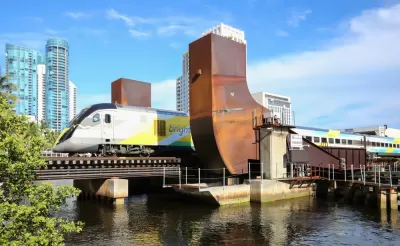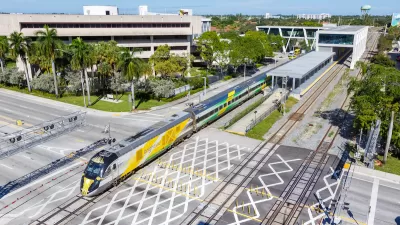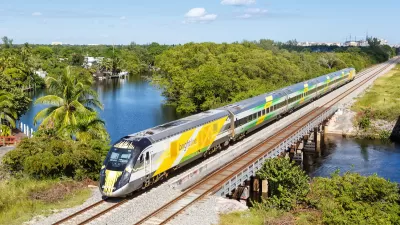The Brightline will connect Orlando to Tampa and reach speeds of up to 150 miles per hour.

Tampa Bay's Brightline train continues its expansion with plans to reach Ybor City in 2028, reports Veronica Brezina. "The envisioned Orlando-to-Tampa route was planned years ago, but the timeline continued to be pushed down the road. However, 2028 is the latest anticipated date for a Tampa station, and documents filed with the TPO confirmed the station would be in Ybor, although an exact address was not listed."
According to Brezina's article, "Brightline is currently finishing its West Palm Beach-to-Orlando route connection, which is 73% complete." When complete, "Brightline’s trains would travel from the Orlando airport using an Orlando Utilities Commission rail spur and existing SunRail tracks to then travel on State Road 417 to the Disney World area, where Brightline plans to have a station."
Christine Kefauver, senior vice president of corporate development at Brightline, "noted how the Ybor City station would have offerings such as bike or scooter parking and sharing areas" to support first and last mile connectivity.
"Brightline expects the Orlando-to-South Florida trains to reach a speed of 125 miles per hour between the two metros during the three-hour-long trip," with speeds of up to 150 miles per hour between Orlando and Tampa. "Previous public records showed Brightline’s rail system from Orlando to Tampa would create thousands of jobs and $787 million in federal, state and local tax revenue over the first 10 years."
FULL STORY: What you need to know about Brightline’s plans for high-speed rail in Tampa Bay

Study: Maui’s Plan to Convert Vacation Rentals to Long-Term Housing Could Cause Nearly $1 Billion Economic Loss
The plan would reduce visitor accommodation by 25,% resulting in 1,900 jobs lost.

North Texas Transit Leaders Tout Benefits of TOD for Growing Region
At a summit focused on transit-oriented development, policymakers discussed how North Texas’ expanded light rail system can serve as a tool for economic growth.

Why Should We Subsidize Public Transportation?
Many public transit agencies face financial stress due to rising costs, declining fare revenue, and declining subsidies. Transit advocates must provide a strong business case for increasing public transit funding.

How to Make US Trains Faster
Changes to boarding platforms and a switch to electric trains could improve U.S. passenger rail service without the added cost of high-speed rail.

Columbia’s Revitalized ‘Loop’ Is a Hub for Local Entrepreneurs
A focus on small businesses is helping a commercial corridor in Columbia, Missouri thrive.

Invasive Insect Threatens Minnesota’s Ash Forests
The Emerald Ash Borer is a rapidly spreading invasive pest threatening Minnesota’s ash trees, and homeowners are encouraged to plant diverse replacement species, avoid moving ash firewood, and monitor for signs of infestation.
Urban Design for Planners 1: Software Tools
This six-course series explores essential urban design concepts using open source software and equips planners with the tools they need to participate fully in the urban design process.
Planning for Universal Design
Learn the tools for implementing Universal Design in planning regulations.
Ascent Environmental
Borough of Carlisle
Institute for Housing and Urban Development Studies (IHS)
City of Grandview
Harvard GSD Executive Education
Toledo-Lucas County Plan Commissions
Salt Lake City
NYU Wagner Graduate School of Public Service





























